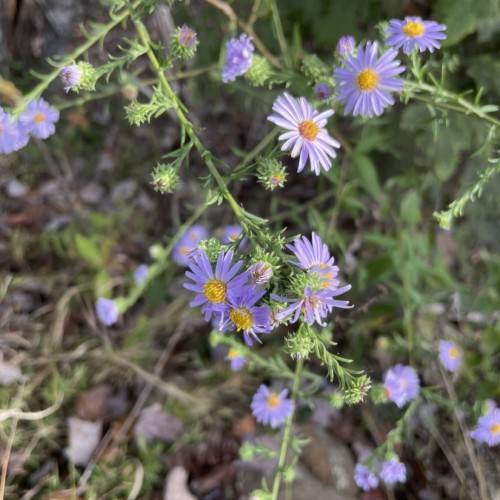
aster
Symphyotrichum anomalum
Cycle:
Herbaceous Perennial
Watering:
Minimum
Hardiness Zone:
5 - 7
Flowers:
Flowers
Sun:
Full sun
Leaf:
Yes
Growth Rate:
Low
Maintenance:
Low
Salt Tolerant:
Yes
Care Level:
Medium
watering
Aster plants should be watered once or twice a week, depending on the growing conditions. The soil should be kept moist but not saturated. For best results, water your aster plants early in the morning or later in the evening. Avoid saturating soil with water late in the day because it increases the chances of disease and fungal infection. During excessive heat, water your asters more often to help prevent them from drying out. If the soil feels dry, give the plants a good soak until water runs out of the bottom of the container. Allow the top couple of inches of soil to dry out before watering again.
sunlight
Aster (Symphyotrichum anomalum) plants prefer full sun for the best growth. Sunlight should be 6 to 8 hours per day and should be evenly distributed throughout the day if possible. When placed in shade, the flowers of aster may be smaller or less vibrant than those grown in full sun. In the northern 2-thirds of the U.S., aster should be planted in an area that receives at least 6 hours of direct sunlight daily. In the southern states, where summer days are longer and hotter, aster should be placed in a slightly shadier spot, where it will receive 6 to 8 hours of morning sun, with some protection from the hot afternoon rays.
pruning
Aster should be pruned in late spring or early summer, when most of the growth for the season has occurred. Pruning aster should involve removing up to half of the plant’s stems, cutting them down to within a few inches of the ground. After pruning, 1 should ensure that they are fertilizing and watering the plant regularly, as pruning can be hard on the plant.
Season
Hardiness Map
FAQ
Is gerbera a member of the Asteraceae family?
Yes, gerbera (Gerbera jamesonii) is a member of the Asteraceae family, commonly known as the daisy, sunflower, or composite family. Gerbera is a genus of about 30 species of flowering plants native to tropical regions of South America, Africa, and Asia. They are grown as ornamental garden and indoor plants, earning them the popular nickname "Gerber Daisy." They usually have a long flowering season and can come in a variety of colors, making them a popular choice for bouquets and floral arrangements.
Do aster flowers attract butterflies and bees?
Yes, aster flowers definitely attract butterflies and bees. Asters are bright, bold garden favorites due to their delicate blossoms, which often feature curved petals that fan out like a star. Their colors range from violet and purple to pink, white, and blue, so they offer a wide range of colors that attract butterflies and bees. Additionally, aster flowers are usually clustered close together, which providesa perfect landing spot for both butterflies and bees.
Is aster flower a good option for landscape design?
Aster flowers are an excellent option for landscape design because of their bright color, attractive shape, and ease of maintenance. Asters have deep colorings that range from purple, to white, to pink, with some varieties having variegated petals. They also come in multiple heights and widths, which makes it easy to fit them into your landscape plan. Finally, asters are quite low-maintenance, only requiring occasional trimming and occasional fertilizing for optimal growth.
Should aster flowers be grown in pots or in the ground?
Aster flowers can be grown both in pots and in the ground depending on the needs of the gardener. When grown in the ground, asters provide homeowners with a stunning border for flower beds or a vibrant addition to any garden. For those who prefer to have plants that move with them, or have limited outside space, asters can be grown in pots. Asters do need well-draining soil and adequate sunlight when planted outdoors, and a larger pot size will be needed to accommodate their deep roots. Whichever method you choose, make sure that your potted or in-ground asters receive the proper care and maintenance to keep them blooming brightly.
Is the aster flower a perennial or an annual plant?
The aster flower is a perennial plant, meaning that it will regrow each year for multiple years. Asters bloom in late summer and fall and can range in color from white and pale pink to deep purple. They are popular flowers for outdoor and indoor gardens, and since they are fairly hardy, they can thrive in a range of soils and temperatures.
Do aster flowers have a strong scent?
Aster flowers typically have a mild scent, though some varieties, such as the purple aster, may have a slightly stronger one. Astilbes, which are closely related to asters, are known to have a more "fragrant" smell. But overall, asters typically do not have an overpowering fragrance.
Should aster flowers be planted in the fall or spring?
Aster flowers should be planted in the fall. By planting asters in the fall, their roots will have time to become established during the colder winter months. This gives the flowers a head start when the warmer spring weather arrives. The blooms will then flower for several weeks. If asters are planted in the spring, they may not have enough time to become firmly established, compromising the flower's longevity and bloom size.
Could aster flowers grow in a rock garden?
Aster flowers can absolutely be grown in a rock garden. They are versatile and are able to adapt to many different growing conditions. The plants thrive in well-drained soil and appreciate the heat reflected off of rocks and stones. A moderate supply of water is required, so regular watering will be necessary. Rock gardens are becoming increasingly popular, and aster flowers are an ideal choice for this type of garden because of their bright colors and long lasting blooms.
